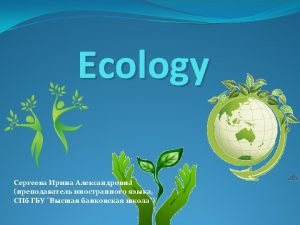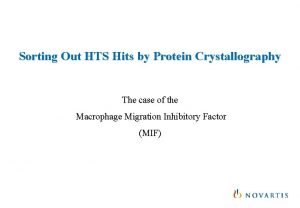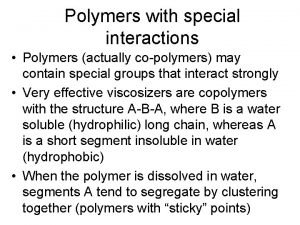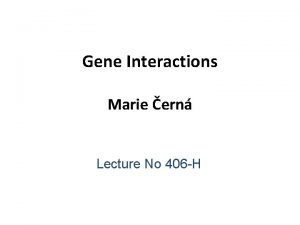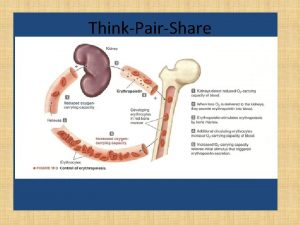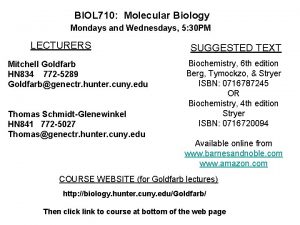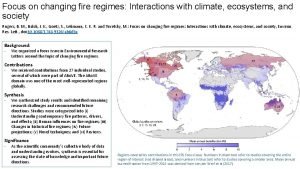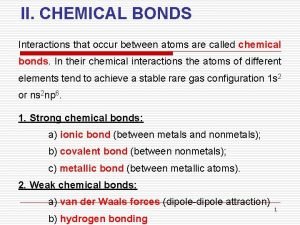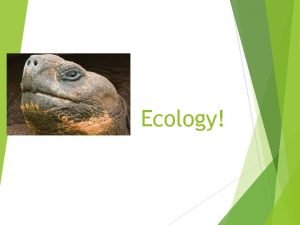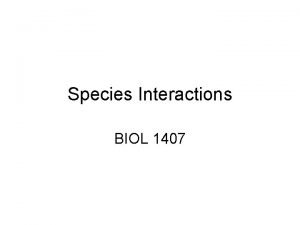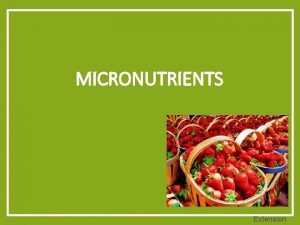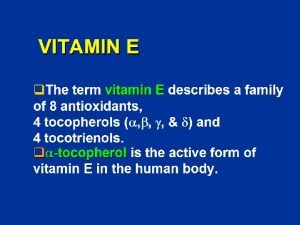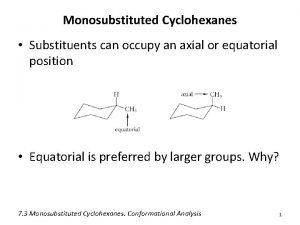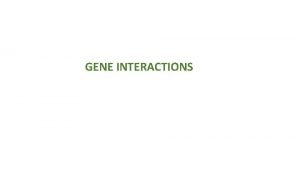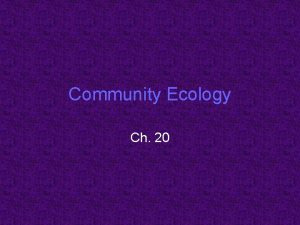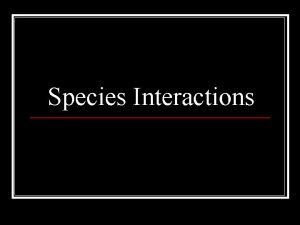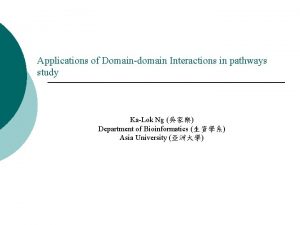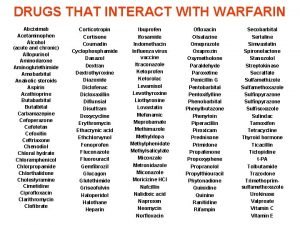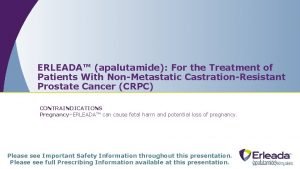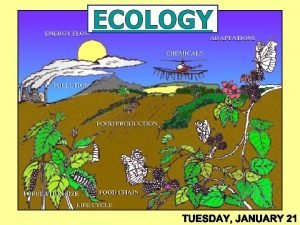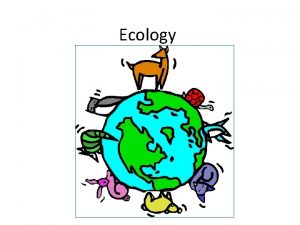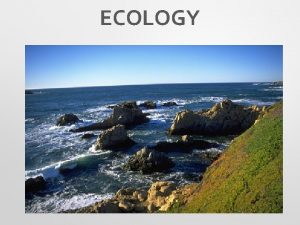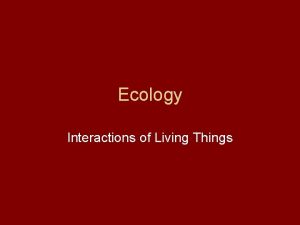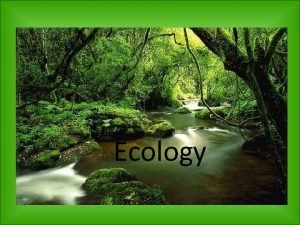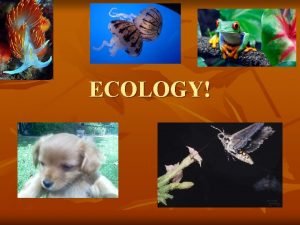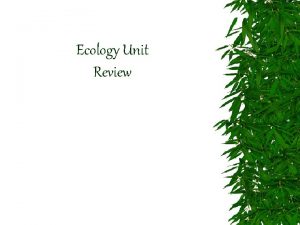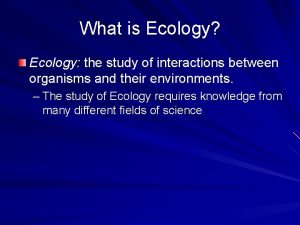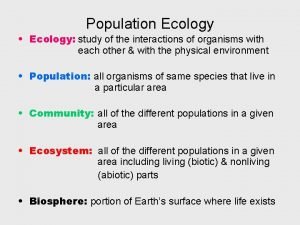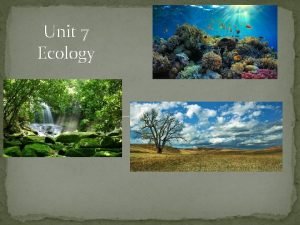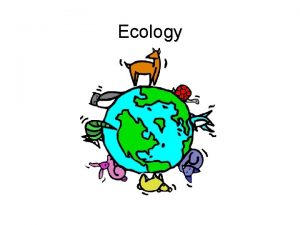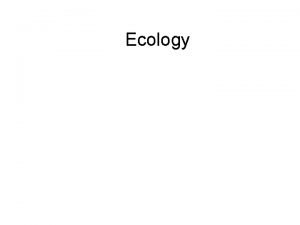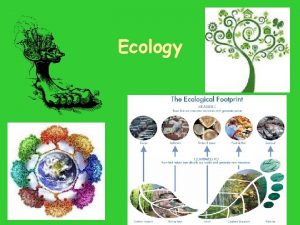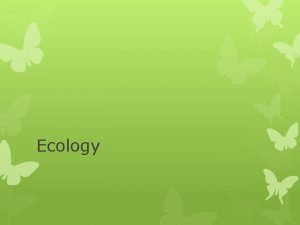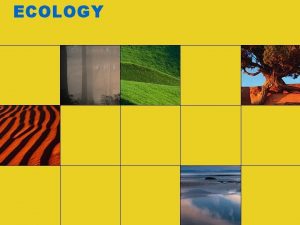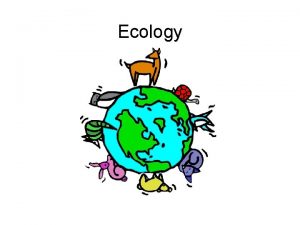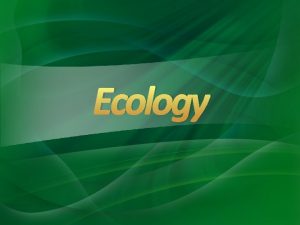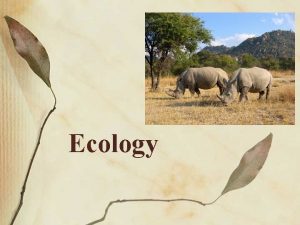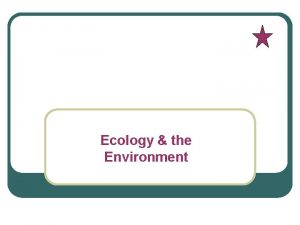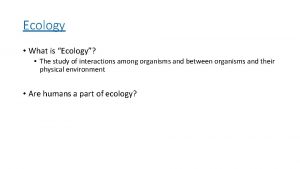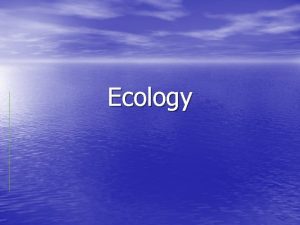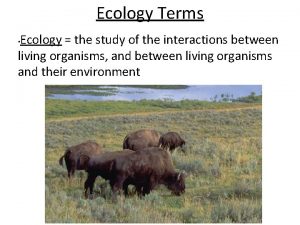Ecology Ecology is the study of the interactions



































- Slides: 35

Ecology

Ecology is the study of the interactions between organisms and their interrelationships with the environment.

Ecology n Organisms Environment


Ø No organism exists as an entity, separate and distinct from its environment. Ø All living organisms are dependent upon other living things as well as dependent on the nonliving environment.




Ecological Organization

Arrange these from largest to smallest Community n Population n Biosphere n Ecosystem n Answer: Biosphere Ecosystem Community Population

Biosphere is the portion of the earth in which life exists – oceans, land & sky.


Ecosystem is the living community and the physical environment functioning together as an interdependent, selfsufficient, and relatively stable system.

* The ecosystem is the structural and functional unit studied in ecology

Community All the plant and animal populations of a given area make up a community.

Population is all the members of a species living in a given location. Ex #1: all the gray squirrels living in a forest Ex #2: All the dandelions growing in a field

species A group of organisms capable of interbreeding and producing fertile offspring

The Liger http: //www. youtube. com/watch? v=CD 6 vphe. Uo. PE

How is the meaning of the word “population” in Biology different from its everyday (common) meaning? In Biology, a population is a smaller group than a community

SUN (radiant energy) What do the arrows represent? Energy A Food Chain

An ecosystem is a self -sustaining unit if the following requirements are met:

Characteristics of Ecosystems 1) constant source of energy. 2) organisms that can store this energy into organic compounds

3) A flow of energy from one population to another - food chains, food webs 4) cycling of materials between the organisms and their environment.


A. Ecosystem Structure & Function Ø An ecosystem involves interactions between abiotic (nonliving) and biotic (living) factors.

Abiotic Factors The abiotic environment includes physical (non-living) factors which affect the ability of organisms to live and reproduce. The abiotic factors include:

• gases - O 2, CO 2, N 2 • temperatures • moisture • substratum • inorganic substances - minerals • light • p. H

Each of these factors may act as a limiting Factor determines the types of organisms which may exist in that environment. Examples of limiting factors include:

• The amount of available water determines the kinds of organisms that can live in a desert.

• The low temperature of regions at high latitude or altitudes. • The salt concentration in the oceans and seashore regions.

Some species of fish, shellfish, and other marine species would die in freshwater due to an imbalance of water pressure in their tissues.

• Some plants live well on a forest floor under tall trees, but would not do well in an open field due to the increased intensity of light.

Biotic Factors are all the living things that directly, or indirectly, affect the environment.

Ø Thus, the organisms, their presence, parts, interaction, and wastes, all act as biotic factors. Ø Biotic factors interact in many ways such as in nutritional relationships and symbiotic relationships.

Nutritional Relationships involve the transfer of nutrients from one organism to another.
 Ecology is the study that helps to preserve
Ecology is the study that helps to preserve Ecology study guide answers
Ecology study guide answers Chapter 3, section 1: community ecology answer key
Chapter 3, section 1: community ecology answer key Protein binding interactions
Protein binding interactions Graphing monetary and fiscal policy interactions
Graphing monetary and fiscal policy interactions Special interactions
Special interactions Regional and transregional interactions
Regional and transregional interactions Chapter 22 reaching out cross-cultural interactions
Chapter 22 reaching out cross-cultural interactions Interactions among living things
Interactions among living things Epistasis types
Epistasis types Integral product architecture
Integral product architecture Organization of the lymphatic system
Organization of the lymphatic system Molecular biology
Molecular biology Interactions
Interactions Abiotic factor
Abiotic factor Accounting information system chapter 1
Accounting information system chapter 1 Interactions between atoms occur
Interactions between atoms occur Symbiosis and species interactions keystone webquest
Symbiosis and species interactions keystone webquest Wikimedia commons
Wikimedia commons Ppi drug interactions
Ppi drug interactions Translucent examples
Translucent examples Wave interactions
Wave interactions Nutrient interactions
Nutrient interactions Beri beri
Beri beri Properties and interactions of magnets
Properties and interactions of magnets Cholinomimetic
Cholinomimetic Diaxial interactions
Diaxial interactions Noncovalent interactions
Noncovalent interactions Gene interaction example
Gene interaction example Section 20-1 review species interactions
Section 20-1 review species interactions Cape buffalo and cattle egrets relationship
Cape buffalo and cattle egrets relationship Protein binding interactions
Protein binding interactions Synergism
Synergism Which of the following tells you population density
Which of the following tells you population density What are sphere interactions?
What are sphere interactions? Erleada mechanism of action
Erleada mechanism of action
